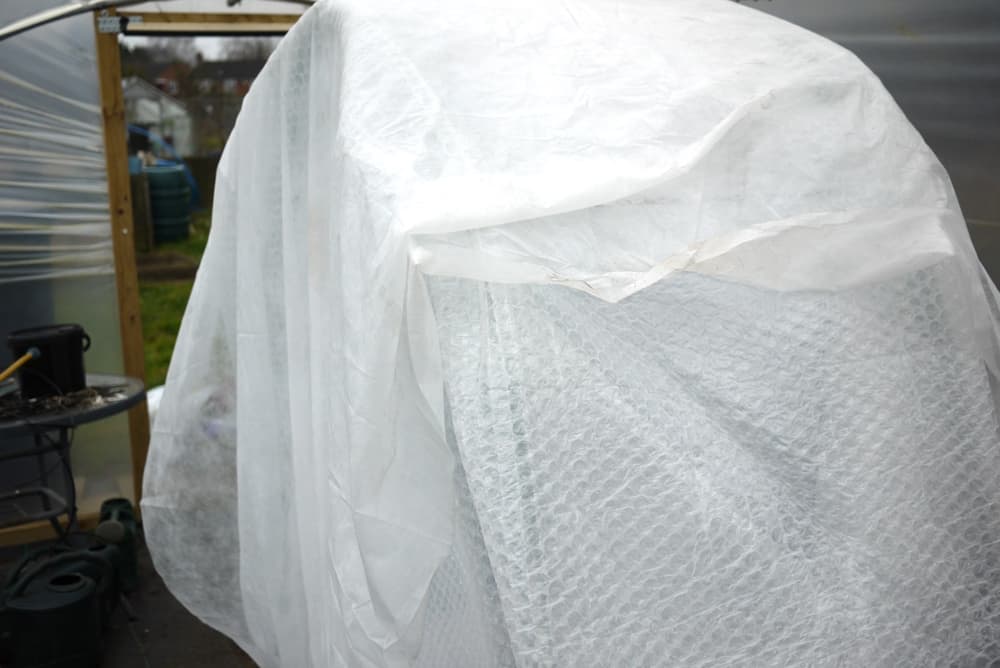How To Keep A Polytunnel Warm


Introduction
How warm is a polytunnel in winter? My experience is that temperatures can drop to the same as outside (ie below freezing).
On this page I share how I was able to raise the minimum daily temperature inside my polytunnel by 4 °C.
The easy way for a gardener to organise their growing and discover gardening ideas.
Step By Step Video
YouTube Video
Hello Two!
Hello Three!
How To Keep A Polytunnel Warm
There are two common approaches to keeping a polytunnel warm:
- Retaining daytime heat
- Creating a heat source inside a polytunnel
Or a combination of the above. Retaining day time heat is essentially providing insulation and draft proofing to keep warm air inside the polytunnel. Even in winter, the power of the sun through the plastic can raise daytime temperatures to 30 °C or more.
There are many possible ways of adding a heat source to a polytunnel:
- Creating a hot bed of decomposing materials that naturally produces heat
- An electric heater or propane gas heater
- Candles
- Using a large water butt filled with water to act like a storage heater
My Approach To Keeping A Polytunnel Warm
The polytunnel on my allotment is several hundred metres from my house. For this reason, I did not want to use unobserved heaters or candles inside it. I had read that a hot bed or water butts can make a difference to night time temperatures, but I decided against both approaches on the basis of convenience.
My approach was based on retaining more daytime heat during the night. The logic behind the decision was that a thermometer inside the polytunnel showed that daytime temperatures were warm – almost as high as in summer (on sunny days) . If I could prevent more of this heat escaping, this seemed the best and easiest solution to the problem.
How Warm Is A Polytunnel In Winter?
I was surprised to discover just how cold my polytunnel got. Put simply, the polytunnel temperatures were the same as outside temperatures. I did not know how long these minimum temperatures lasted for, or how quickly the temperatures recovered at daybreak. However, I had discovered that the temperatures was too low for my plants.

Simply shutting the polytunnel door in winter was not enough to protect my autumn geranium cuttings. My assumption was that there would be enough daytime heat to protect the plants at night. Also, that the absence of windchill would mean the plants would survive.
Draft Proofing

My first attempt at warming the polytunnel was draft proofing. At each end of my polytunnel are doors with a net panel. These are very helpful in the summer to aid air circulation and to cool the tunnel, but in winter simply let all the hot air out. Therefore I covered these with plastic.

Similarly, around the doors are large gaps between the doors and the door frames. I fitted draft excluders to help retain heat inside the tunnel.
Using A Growhouse Inside The Polytunnel
I found that reducing drafts made little difference to the heat loss experienced by the polytunnel. The next attempt was to install a plastic growhouse. I decided to use a Horti Hood plastic greenhouse as this fitted comfortably inside the polytunnel.

My thought that the plastic greenhouse would offer even better protection from drafts, and would have some sort of double glazing effect. In fact, the greenhouse did make a difference, but only by 1 -2 °C. There was simply too much heat loss through the plastic.
Insulating The Plastic Greenhouse
Encouraged that I was now heading in the right direction, I decided to invest in some proper gardener’s bubble wrap insulation.

This insulation is UV protected to last longer than packaging bubble wrap, and has much larger bubbles. These bubbles allow more light (and therefore heat) to enter, and provide more insulation.

Results
For all the tests, I compared the temperature difference between a thermometer in my garden, to a thermometer inside my polytunnel (and growhouse). With all the insulation in place, I had managed to increase the minimum temperature inside the polytunnel by 4 °C.

Nevertheless, I was still concerned about the minimum temperatures, as the thermometer showed these could still fall to below zero or particularly cold nights.
For one week, I tested the set up with some daisy cuttings that had previously been nurtured on a warm sunny windowsill. These have all survived with no signs of damage. I believe this is most likely to be because the minimum temperatures experience within the polytunnel growhouse are only for short periods of time.
